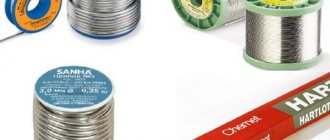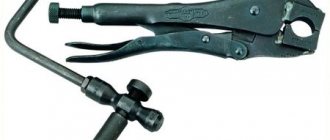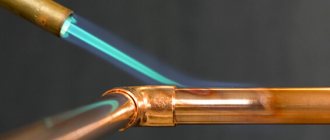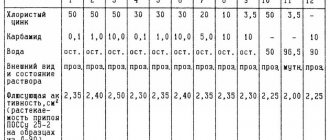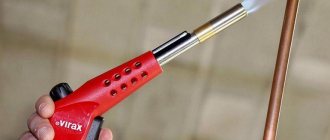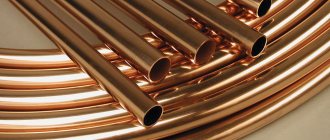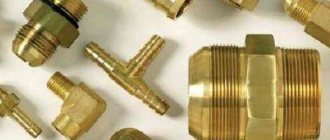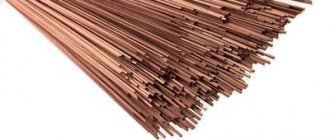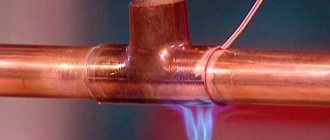Rolled copper pipes of various sizes are used to create utilities, heating and cooling equipment. When installing systems and repairing equipment, it is almost always necessary to connect pipe elements to each other or to other structural parts.
The work is carried out using soldering or special union couplings. To obtain a tight connection, copper tubes are often first flared. This operation is also called rolling.
Flaring
However, in a professional environment, the concepts have different meanings. Therefore, it is necessary to find out what these two processes are and how they differ. This will allow further work to be completed correctly.
Flaring and rolling for copper pipes
Both concepts represent technological operations performed using different equipment. Although most ordinary people refer to these two processes as carrying out the same actions.
Rolling is performed on a special machine, the design of which contains work rolls. With their help, sheet or pipe products are deformed. Therefore, rolling is a process that makes it possible to produce products with a different cross-section from round pipes.
When flaring copper pipes, a tool without rolls is used. It allows you to deform only the ends of the rolled pipe. Therefore, flaring is an operation to change the internal and external diameters of exclusively the ends of a copper tube under the influence of mechanical load.
That is, rolling is a tool. Flaring is a technological action. Here's what Wikipedia says.
As a result of the process, the ends of the rolled pipe take the shape of a cone. The ends of the tubes are also flared in the form of a mushroom or with a double funnel. The last operation is carried out in 2 steps: first, a so-called fungus is created on the end, and then it is crushed with a cone.
Most often, flaring is performed when you need to reliably connect two parts of small diameter. Expanding the end allows you to fit the pipe onto the same product, equipment pipe or fitting.
Thanks to this, soldering does not have to be done end-to-end when using shaped parts that need to be inserted into the elements to be joined. Therefore, there will be no reduction in the internal size of the node. This allows you to maintain the system throughput at the same level.
Flaring technology and stages
Rolled copper pipes are connected using soldering or couplings. The option used affects the specifics of flaring.
Before soldering, the end of the pipe is expanded until another part fits into it. The difference between the inner diameter of the tube and the cross-sectional size of the inserted element should be 0.1-0.2 mm. This gap is filled with solder during soldering. Therefore, a tight and durable connection is formed.
When using a fitting, a chamfer is created on the edge of the pipe before expansion. It should have an angle of 45⁰. The chamfer allows you to increase the contact area of 2 parts. This increases the reliability of the connection.
The tightness of the joint is also ensured by the natural plasticity of the non-ferrous metal. When the coupling is tightened, the soft copper tightly grips the fitting, eliminating any gaps.
Flaring process for copper pipes.
The process of correct and high-quality flaring of copper tubes for air conditioners, heating heat exchangers and various engineering systems is carried out in the following sequence:
- The rolled pipe is cut strictly perpendicular to its axis.
- The cut and the outer surface near the end of the tube are cleaned.
- If necessary, the round shape of the section must be restored if the part was deformed during cutting.
- A crimp nut is placed on the pipe if the connection is made using a fitting.
- The copper pipe element is fixed in the rolling tool. The edge of the part, 5-6 mm long, should remain free.
- A stamp of the required size is inserted into the holes of the tube. It is gradually screwed into the product, which leads to softening and stretching of the metal. As a result, the edge of the pipe takes the form of a cone.
- The expander with a stamp and the holder are removed from the rental.
At the end of the operation, the end of the product is inspected for the presence of burrs. When they are discovered, they must be cleared. There should also be no cracks on the flared edge.
Completion of tube flaring.
The edges of the created bell must be parallel to each other. If such defects are detected, it is necessary to cut off the extended end and repeat the entire process.
How to flare a stainless steel tube
Pipe rolling or rolling is a technological process, the purpose of which is to deform them in different directions. Thanks to this operation, it is possible to create a suitable material for laying water pipes and other parts used in everyday life or industry.
How to make a tool
The ideal solution is to purchase a ready-made machine. But if this option is not suitable, and it was not possible to give the required diameter to the workpiece with your bare hands, we will make a tool for the work ourselves, since at home it is impossible to flare a copper tube efficiently without a device.
Drawing of a homemade rolling machine
The metal is soft, but we need to achieve an exact match between the end of the tubes and the landing cone, otherwise we will not be able to achieve a tight connection.
Once you've made your copper pipe bender, you'll be able to use it for years to come, making the project worth the effort. The design of the device is simple - it is a frame made of two identical corners.
What tools will you need for the job:
- sharpening machine;
- drilling machine;
- Bulgarian.
- two corners 100 mm long (shelf – 32 mm, thickness – from 5 mm);
- two M8 bolts;
- mandrels (can be ordered from a turner or turned yourself).
We do the rolling:
- We fasten the corners with bolts.
- We drill chamfers and holes in the base.
This rolling kit will allow you to independently make an ideal fastener from any cut of copper pipe. You need to work on it in the same way as on a ready-made, purchased flaring machine.
How to flare a copper tube
- The workpiece must be clamped in the holder in a position in which it will protrude beyond its edges by 5-6 mm.
- Instead of a cone, we install a die of a diameter suitable for the workpiece.
- We put on the fittings. Pay attention to the direction of the thread (it should be facing in different directions, towards the ends of the workpiece - away from each other).
- We screw in the stamp with force, the edge of the end is flattened.
- We remove the stamp and put a cone in its place.
- Screw in the cone. You need to work gradually, carefully moving the cone deeper to the required mark.
- We take the part out of the holder and inspect it carefully. If necessary, we clean it.
Our result is a neat flared part, ready for use.
Using the tips given in the article, you can independently make the necessary kit for flaring tubes of different diameters. This approach will save money on the purchase of ready-made machines. And the efficiency of work on a homemade unit is no worse, and you don’t need any special talents to make it. Good luck in job!
: flaring of copper pipes
What is pipe flaring and how does it happen?
Manufacturing pipes or modifying them for use in a particular system involves a variety of impacts. Both thermal and cold processing methods are used. Most cold processes involve rollers.
Manual flaring machine
Often this type of work is combined into one category - flaring, which is completely wrong.
Rolling: what does it mean?
The term is used to refer to the following processes.
- Rolling - the main technological operation in the production of a seamless pipeline is the formation of a product from a round billet. The workpiece is stretched, thinned and calibrated on the appropriate equipment - rollers. Hence the name.
- Flaring does not require the participation of rollers and can be done by hand. Its essence is to increase the diameter of the pipe edge using mechanical action. This need often arises when connecting straight segments.
A high-quality joint involves inserting one section into the sleeve - expanding, another and sealing the gap. But since not all products have such a sleeve, you have to do the operation yourself. In everyday life, flaring is usually understood as this process.
- Rolling is the reverse operation: crimping the edge of the pipe before inserting it into the sleeve. If manual threading involves cutting the thread, the edge of the pipeline also needs to be reduced in volume - rolled. Conventional pliers or miniature rollers are used for this.
- Bending – Most pipe bending machines, both manual and hydraulic, include rollers. The product is inserted into the machine, the deforming roller is rolled along the length of the segment and gradually bent at the required angle. Since the operation involves rollers, this process is also often called flaring. Water pipelines made of stainless steel and aluminum are subject to bending.
Only the second option can be legitimately called this - increasing the diameter of the edge before joining. GOST regulates the qualitative and quantitative characteristics of the rolling result.
The operation involves products made of stainless steel, aluminum and copper - that is, a material with a certain level of ductility. For this purpose, both home-made and special devices are used. To flare pipes with large diameters, professional equipment is required.
Flared edges can most often be found on medium- and large-diameter sewer lines. It is their dimensions and permissible error that are described by GOST.
At home, you often have to deal with copper pipes. But stainless steel products are subject to rolling. The process technology is the same for any tool.
- The end of the segment is cleaned and burrs are removed.
- A coupling is put on the edge.
- The pipe is installed in some kind of flaring device and clamped.
- If we are talking about a manual device, then it looks like this: the flaring cone, when the screw is screwed in, puts pressure on the inner surface of the water conduit and deforms it.
- The flaring tool is removed. The end of the segment should have a regular funnel shape with walls beveled at an angle of 45 degrees.
- Then the coupling is moved to the flared edge and the nut is tightened.
The video demonstrates the flaring of a copper pipe before joining.
Flaring Tools
When installing a copper pipeline with your own hands, a hand-held device is sufficient. Copper is a ductile metal. Forming a funnel-shaped edge requires not so much effort as accuracy. The funnel should be completely symmetrical, without distortions or chips.
- The simplest mechanism consists of two parts: a clamp with standard diameters - a metal plate in which the product is held, and a cone with a screw. The photo shows a sample.
- An extender is a lever tool with a replaceable expansion head for different diameters. The extender is fixed to the edge, the levers are moved apart and the legs stretch the pipe.
Why is pipe rolling necessary when installing various systems?
Pipes are rolled to give them the required shape and size for installation with the pipeline system. It implies directed deformation in a given direction. To implement the process independently, mobile, professional rolling machines are used.
Flared copper tubes
With their help, it is possible to achieve uniform expansion of the walls without the risk of rupture of the product.
Where is flaring used?
Rolling may be necessary in the following cases:
- in the manufacture of water and gas pipelines;
- brake systems;
- when installing air conditioners;
- in the repair of freezers, heat pumps.
Flaring of products is required in areas with low maximum pressure limits. It allows you to use the effective socket method for connecting sections of pipeline, when one end of the pipe is placed in the socket of the second section. The resulting joint is secured with couplings, gluing or soldering.
Three-roller pipe benders are common rollers for profile pipes. This machine is suitable for rolling products of square, round and rectangular shapes. It also lends itself to stainless, steel, and aluminum pipes. A pipe bender allows you to bend it into a circle or arc. This tool works on both sides.
One of them is aimed at deforming small-diameter pipes, and the second is aimed at bending large-diameter products. Using a pipe bender you can also bend the strip.
Modifying a pipe using a pipe bender may be necessary in the following cases:
- if a finished part of the required type is not available;
- if it is necessary to adjust the size of the segment as accurately as possible or a special, non-standard bend is required.
How to choose a flaring machine?
Any device for pipe flaring is a specific device aimed at radically deforming pipes made of different types of materials. Using the tool, it is possible to ensure a press connection of pipeline sections.
Pipe flaring tool
The master's kit includes both electrical and mechanical products. An electric tool often has a pipe bender in its design, which allows you to flare significant volumes of pieces with your own hands.
The roller's kit may include templates and expanders, but their use is not effective. Aluminum, stainless and steel pipes are deformed more evenly under the influence of an electrical or mechanical device. The same wall thickness is maintained throughout the entire segment and the surface remains smooth.
Rolling tool for copper pipes
Rolled copper pipes are soft and elastic products. Therefore, you can expand the tube using a makeshift method. To do this, the rolled product is simply pulled onto a blank in the form of a cone of the required size. However, it is very difficult to create a bell without breaking the geometry.
Often the walls of the expanded area are obtained with different thicknesses. The created bell also often develops skew. All such defects appear due to the uneven force that a person applies when flaring using a handicraft method.
A neat bell of the correct geometric shape can be obtained using a special tool. Only it will allow you to perform high-quality rolling for copper pipes of an air conditioner or other equipment.
Expander
The tool is a hand-held device that operates using physical force. The expander design includes two levers and a cone-shaped sliding expander. Rolling is done by pressing on the handles after the tool head is inserted into the pipe.
The expander allows you to quickly complete the job with minimal labor costs. The tool kit includes a set of rolling pins selected for the internal diameter of the parts. However, they stretch the rolled walls unevenly, which makes it difficult to obtain a high-quality result. After all, thinner areas may simply burst.
Conical
This type of tool consists of two parts. One of them is a matrix. It is a device in the form of a vice with cylindrical holes, each of which in the upper part is expanded at an angle of 45°.
The second element of the device is a flaring machine, consisting of the following parts:
- housings with guides;
- cone-shaped expander;
- control mechanism;
- power screw.
When physical force is applied to the control mechanism, the power screw begins to rotate. The expander is screwed into the pipe. This leads to softening of the metal. As a result, the edge of the product takes on a conical shape in accordance with the expansion of the hole in the matrix.
Rolling for copper pipes
Thanks to the guides, the copper tube and the expander are always in the same axis. Their position does not change during the process. Therefore, you get a neat bell without distortions and with smooth edges.
Mechanical
This device has a similar design to a cone flaring machine. The difference lies in the working body. A mechanical flaring machine uses a set of rollers instead of a cone expander.
Set of rollers for copper pipes.
They uniformly roll out the rolled edge. Therefore, it is possible to perform flaring with the same thickness over the entire area of the created socket.
Electrically driven
This is the most expensive type of instrument. It features high performance. For this reason, the battery device is used by installation companies when performing a large volume of work.
How to flare a stainless steel pipe with your own hands?
Pipe rolling or rolling is a technological process, the purpose of which is to deform them in different directions. Thanks to this operation, it is possible to create a suitable material for laying water pipes and other parts used in everyday life or industry.
Rolling tool
Like rolling metal sheets, rolling stainless steel pipes is carried out using special tools and bending machines. With their help, you can easily give the product the desired shape without affecting its chemical properties.
There are a huge number of tools for rolling. Each of them is designed for pipes with a specific diameter.
- To fix the depth of products with a diameter of 6-11 mm, it is customary to use T series equipment.
- CT type tools are suitable for pipes that have the same diameter behind the weld seam.
- For diameter 5.5-11.5 mm - RT.
- The P series is intended for more serious structures, from 12 to 40 mm.
- CP equipment is useful when rolling thick tube sheets.
- Finally, for thin-walled stainless steel pipes, you will need a tool marked 5P.
Rolling, as such, can be carried out both in a special workshop and in a regular workroom. As a rule, rolling tools are made from high-quality alloys, and therefore they do not require repair for a long time.
Stages and features of rolling
The process itself takes place in three main stages. During rolling, the product expands under the influence of high temperature and physical pressure. During direct rolling, it is given the required shape. Finally, the last step is flaring, which ensures the tightness of the connection.
It is worth noting that excessive physical impact on a stainless pipe can ruin its properties, and therefore the rolling process should be carried out with special attention.
Flaring copper tubes at home
Adjusting the diameters of pipes when connecting them is not an easy task. Either there is no workpiece of the required size, or the wall thickness in different parts of the part differs.
But the need to work with product diameters arises not only in industry; expansion of structures for hermetically sealed fastening of household communications is also often required.
Let's find out what do-it-yourself flaring of copper tubes is, why it is carried out and how to proceed to get a good result.
The essence of the process
Radial deformation or flaring of copper pipes in the hole of a special apparatus is necessary to create a strong adhesion of structural elements, for example, a pipe with a tube sheet. In this way, parts are secured in condensers, boilers, oil coolers, steam generators and other heat exchangers.
This is what a flared pipe looks like
Stages of pipe flaring
Manipulations are carried out in three stages:
- The required gap between the part and the tube sheet is selected.
- Both elements are deformed.
- The pressure (load) is removed from the outer surface of the deformed workpiece.
During the process of flaring copper tubes, the metal softens, stretches (goes into a state of plastic deformation), and the tube sheet material goes into a state of elastic deformation. For the manipulation to be successful, the grating material must be harder than copper.
At the end of the flaring process, the grid “encircles” the pipe section. We obtain a press connection, the strength of which is ensured by the contact pressure of the surface of the part and the grid hole.
Proper stretching will allow you to achieve maximum tightness of the connection.
Sometimes welding is used to connect these elements - this type of fastening is called combined. When installing a copper water supply, one of the parts is expanded, then a second pipe is inserted into it, after which the gap between them is filled with solder.
For combined connections, welding is used
It may be necessary to change the diameter of parts in the following cases:
- If a stamped (cast) product of the required shape cannot be purchased ready-made (it is not produced or is out of stock).
- A delicate adjustment of the bending angle, the size of the tube or its internal diameter is required.
Ways to increase pipe diameter
The tool used to carry out the manipulation is called a copper tube roller. In industry, high-strength shafts are used, which are rolled several times, resulting in a profile of the desired configuration. Work can be performed on special machines and machines, bending rollers.
Rolling machine allows deformation to be carried out evenly
Copper is a ductile material, so if you have dexterity and great physical strength, you can manually try to pull a copper blank onto a conical template (blank) to get the desired connection.
They resort to this homemade method, which does not use rolling for copper pipes, in extreme cases, since the result is difficult to predict.
There may be ruptures in places that bear the maximum tensile load; a thin part may simply become wrinkled and become unusable due to uneven thinning of the pipe walls.
The second option is intermediate between full processing of workpieces and stretching parts by force - using an expander. The device has several replaceable nozzles that allow you to use a lever to stretch the pipe to the desired diameter in one go.
Recommendations for the use of flaring for copper tubes
High-quality flaring allows you to create a reliable and tight connection. This can only be done if you have experience. Therefore, it is recommended to practice on sections of rolled pipes of different diameters before the main installation work.
To perform high-quality flaring, also adhere to other expert advice:
- You only need to flare a pipe whose end is free of burrs, debris and various defects, including bends. The edge of the product should have a round shape.
- The expansion tip of the tool must be positioned without distortion relative to the axis of the pipe.
- When expanding a part using a homemade method, the cone-shaped blank should not be pressed, but screwed into the hole of the rolled product.
- When using a device with a matrix, it is necessary to select a hole in the bar with a size corresponding to the diameter of the workpiece.
The outer surface of the pipe near the end should always be cleaned with an abrasive sponge, regardless of the tool used. This will remove debris and dust from the product. Therefore, it will be easier to securely fix the pipe part in the holder.
Flaring tool set
When doing it at home yourself, you first need to prepare the main tool:
- pipe cutter;
- chamfering rimmer;
- one of the available flaring machines.
Tube flaring kit.
The flaring process must be carried out in stages. If you follow all the nuances and recommendations of specialists, it will be possible to create neat sockets with the correct geometry at the ends of the pipes. Therefore, the connections will be tight and reliable.
Tools for heat exchangers. Yesterday and today
History of rolling
started with percussion instruments.
The tubes of the first steam boilers and condensers were sealed in tube sheets using ball mandrels and heavy hammers. Flaring
was carried out in several passes with the diameter of the mandrel ball increasing with each pass.
Then a mandrel began to be used - a long rod with cylindrical tides evenly distributed along its length. The diameter of the tides increased linearly from cylinder to cylinder. The mandrel was pulled through the pipe of the heat exchanger, flaring the pipe
in the grid. Later, the first representatives of cam and collet tools began to appear. In them, the rolling elements - split cams - were pulled by hydraulic pressure along a conical guide, deforming the pipe in the radial direction. The main disadvantage of this method was the inevitable occurrence of sliding friction at the point of contact of the cam with the pipe, and as a consequence the occurrence of local damage.
A breakthrough in rolling technology was the use of rotational motion, and self-tightening rolling machines appeared.
Instead of split cams, they used rollers or rollers, which rolled in a housing-holder along a conical guide-spindle, running into its larger diameter. Thus, with a rolling insert inserted into the pipe, the shank was set into rotation, the rollers, running onto the spindle, came out of the cage, rested against the pipe, rolled along it, simultaneously carrying out its radial deformation. The connection turned out to be uniformly deformed, sealed and reliable.
Currently, due to the growth of technological requirements for heat exchange equipment (pressure, temperature, medium flow, turnaround time), tube sheets of increased thickness, double tube sheets are used in the design of heat transfer steel; elements are added to the profile of the hole for pipes that increase the efficiency of the connection — grooves, the diameters of the holes in the tube sheets increase. The requirements for the roller drive are becoming more complex in terms of adjusting the rotational torque and weight and size characteristics.
Often, production does not require single tools; it requires equipment with a set of tools and devices:
- for preparing the rolling process ( rollers
and
groovers
with a drive, machines for removing fins at the ends of pipes); - for carrying out the rolling process (rolling with pneumatic or electric rolling machines
); - for post-rolling processing (devices for cutting off protruding ends, trimming tools, pipe cutters for steel pipes
); - for repair of rolling joints (tools for removing pipes from tube sheets, machines for processing and drilling pipes).
To meet the growing demands on tools, new types of rolling mills are being developed, such as:
- type CP - for securing pipes in thick tube sheets;
- type RA - for securing pipes in gratings located in closed chambers with limited access;
- type RT – with adjustable rolling depth.
And this is not a complete list. Thus, in the manufacture of heat exchange equipment, one of the domestic manufacturers uses rolling of the NITL
5k-205-210, allowing you
to roll pipes
with a diameter of just over 216 mm! The diameter of one roller is 58 mm, the weight of the tool is 26 kg. There are no analogues to this product in Russia.
Anyone who has ever worked with one or another processing tool, be it a regular drill for a drill stand
or high-tech rolling, knows the important role played by indicators of reliability and ease of use. If the tool is structurally simple and repairable, then it automatically acquires the status of irreplaceable.
Even in the manufacture of conventionally one- or two-component tools (drill, cutter, etc.), giving them the above qualities causes difficulties; everyone is familiar with the crude term “Chinese tool”, which characterizes a low production culture.
When considering a multi-component special tool ( pipe rolling
, flattener, groover,
end-cutter for pipes
, etc.) compliance with high indicators of service life, maintainability and ergonomics places strict demands on manufacturing technology, which is beyond the capabilities of many manufacturers. That is why there are no more than a dozen industries in the world that are capable of solving such a complex of engineering and technological problems.
It is gratifying to realize that in the field of tool manufacturing technologies for the production and repair of heat exchange equipment, Russia occupies one of the leading positions.
Conclusion and video on the topic
High-quality rolling at the ends of copper pipes for heating, air conditioning, and plumbing systems can only be performed using a special tool. When choosing a device, you need to consider how often it will be used.
For one-time work at home, it is better to rent a tool or from friends. An expensive device will only pay for itself when large-scale installation work is carried out. Regardless of the type of flaring machine, it must be purchased after checking its functionality.
Video review of rolling machines for copper pipes
The video will help you understand the choice of tool and flaring of the ends of copper tubes.
